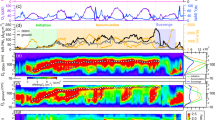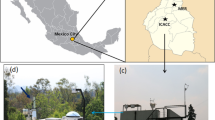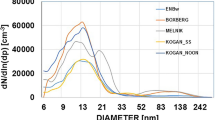Abstract
Natural and anthropogenic biomass burning are among the major sources of particulate pollution worldwide that affects air quality, climate and human health. Delhi, one of the world’s most populated cities, experiences severe haze events caused by particulate pollution during winter, but the underlying pathways remain poorly understood. Here we observe intense and frequent nocturnal particle growth events during haze development in Delhi from measurements of aerosols and gases during January–February at the Indian Institute of Technology in Delhi. The particle growth events occur systematically despite the unfavourable condition for new-particle formation, including the lack of photochemical production of low-volatility vapours and considerable loss of vapours under extremely polluted conditions. We estimate that this process is responsible for 70% of the total particle-number concentration during haze. We identify that the condensation of primary organic vapours from biomass burning is the leading cause of the observed growth. The sharp decrease in night-time temperatures and rapid increase in biomass-burning emissions drive these primary organic vapours out of equilibrium, resulting in their condensation and the growth of nanoparticles into sizes relevant for haze formation. This high impact of primary biomass-burning emissions on night-time nanoparticle growth is unique compared with most urban locations globally, where low-volatility vapours formed through oxidation during the day drive particle growth and haze formation. As uncontrolled biomass burning for residential heating and cooking is rife in the Indo–Gangetic plain, we expect this growth mechanism to be a source of ultrafine particles, affecting the health of 5% of the world’s population and impacting the regional climate. Our work implies that regulating uncontrolled biomass-combustion emissions may help inhibit nocturnal haze formation and improve human health in India.
This is a preview of subscription content, access via your institution
Access options
Access Nature and 54 other Nature Portfolio journals
Get Nature+, our best-value online-access subscription
$29.99 / 30 days
cancel any time
Subscribe to this journal
Receive 12 print issues and online access
$259.00 per year
only $21.58 per issue
Buy this article
- Purchase on Springer Link
- Instant access to full article PDF
Prices may be subject to local taxes which are calculated during checkout




Similar content being viewed by others
Data availability
All the data displayed in figures, including concentrations of particle-number concentration and NR-PM1 species measured by the HR-ToF-AMS in Delhi in this study, are available in the Figshare repository: https://doi.org/10.6084/m9.figshare.21932136. Source data are provided with this paper.
Code availability
Codes for the thermodynamic modelling conducting the analysis presented here can be obtained upon request from the corresponding author.
References
IQAir. World Air Quality Report. 2019 World Air Qual. Rep. 1–35 (2019).
Beig, G. et al. Anatomy of the winter 2017 air quality emergency in Delhi. Sci. Total Environ. 681, 305–311 (2019).
Kanawade, V. P. et al. What caused severe air pollution episode of November 2016 in New Delhi? Atmos. Environ. 222, 117125 (2020).
Ravindra, K. et al. Real-time monitoring of air pollutants in seven cities of North India during crop residue burning and their relationship with meteorology and transboundary movement of air. Sci. Total Environ. 690, 717–729 (2019).
Zhang, R., Khalizov, A., Wang, L., Hu, M. & Xu, W. Nucleation and growth of nanoparticles in the atmosphere. Chem. Rev. 112, 1957–2011 (2012).
Zhang, R. et al. Formation of urban fine particulate matter. Chem. Rev. 115, 3803–3855 (2015).
Kulmala, M., Kerminen, V. M., Petäjä, T., Ding, A. J. & Wang, L. Atmospheric gas-to-particle conversion: why NPF events are observed in megacities? Faraday Discuss. 200, 271–288 (2017).
Yao, L. et al. Atmospheric new particle formation from sulfuric acid and amines in a Chinese megacity. Science 361, 278–281 (2018).
Salimi, F., Rahman, M. M., Clifford, S., Ristovski, Z. & Morawska, L. Nocturnal new particle formation events in urban environments. Atmos. Chem. Phys. 17, 521–530 (2017).
Kanawade, V. P. et al. Observations of new particle formation at two distinct Indian subcontinental urban locations. Atmos. Environ. 96, 370–379 (2014).
Sebastian, M., Kanawade, V. P. & Pierce, J. R. Observation of sub-3 nm particles and new particle formation at an urban location in India. Atmos. Environ. 256, 118460 (2021).
Gani, S. et al. Submicron aerosol composition in the world’s most polluted megacity: the Delhi Aerosol Supersite study. Atmos. Chem. Phys. 19, 6843–6859 (2019).
Tobler, A. et al. Chemical characterization of PM2.5 and source apportionment of organic aerosol in New Delhi, India. Sci. Total Environ. 745, 140924 (2020).
Gunthe, S. S. et al. Enhanced aerosol particle growth sustained by high continental chlorine emission in India. Nat. Geosci. https://doi.org/10.1038/s41561-020-00677-x (2021).
Ojha, N. et al. On the widespread enhancement in fine particulate matter across the Indo–Gangetic Plain towards winter. Sci. Rep. 10, 5862 (2020).
Sembhi, H. et al. Post-monsoon air quality degradation across northern India: assessing the impact of policy-related shifts in timing and amount of crop residue burnt. Environ. Res. Lett. 15, 104067 (2020).
Andreae, M. O. & Merlet, P. Emission of trace gases and aerosols from biomass burning. Glob. Biogeochem. Cycles 15, 955–966 (2001).
Bruns, E. A. et al. Identification of significant precursor gases of secondary organic aerosols from residential wood combustion. Sci. Rep. 6, 27881 (2016).
Lim, C. Y. et al. Secondary organic aerosol formation from the laboratory oxidation of biomass burning emissions. Atmos. Chem. Phys. 19, 12797–12809 (2019).
Kodros, J. K. et al. Rapid dark aging of biomass burning as an overlooked source of oxidized organic aerosol. Proc. Natl Acad. Sci. USA 117, 33028–33033 (2020).
Decker, Z. C. J. et al. Nighttime chemical transformation in biomass burning plumes: a box model analysis initialized with aircraft observations. Environ. Sci. Technol. 53, 2529–2538 (2019).
Wei, Y. et al. Nocturnal PM2.5 explosive growth dominates severe haze in the rural North China Plain. Atmos. Res. 242, 105020 (2020).
Zhu, Y. et al. Comparative analysis of new particle formation events in less and severely polluted urban atmosphere. Atmos. Environ. 98, 655–664 (2014).
An, J. et al. Characteristics of new particle formation events in Nanjing, China: effect of water-soluble ions. Atmos. Environ. 108, 32–40 (2015).
Canagaratna, M. R. et al. Chemical and microphysical characterization of ambient aerosols with the aerodyne mass spectrometer. Mass Spectrom. Rev. 26, 185–222 (2007).
Kulmala, M. et al. Is reducing new particle formation a plausible solution to mitigate particulate air pollution in Beijing and other Chinese megacities? Faraday Discuss. https://doi.org/10.1039/d0fd00078g (2021).
Chen, Y. et al. Ammonium chloride associated aerosol liquid water enhances haze in Delhi, India. Environ. Sci. Technol. https://doi.org/10.1021/acs.est.2c00650 (2022).
Xie, M., Hannigan, M. P. & Barsanti, K. C. Gas/particle partitioning of 2-methyltetrols and levoglucosan at an urban site in Denver. Environ. Sci. Technol. 48, 2835–2842 (2014).
Wang, M. et al. Photo-oxidation of aromatic hydrocarbons produces low-volatility organic compounds. Environ. Sci. Technol. 54, 7911–7921 (2020).
Nieminen, T., Lehtinen, K. E. J. & Kulmala, M. Sub-10 nm particle growth by vapor condensation—effects of vapor molecule size and particle thermal speed. Atmos. Chem. Phys. 10, 9773–9779 (2010).
Rai, P. et al. Real-time measurement and source apportionment of elements in Delhi’s atmosphere. Sci. Total Environ. 742, 140332 (2020).
Kuttippurath, J. et al. Record high levels of atmospheric ammonia over India: spatial and temporal analyses. Sci. Total Environ. 740, 139986 (2020).
Aiken, A. C. et al. Mexico City aerosol analysis during MILAGRO using high resolution aerosol mass spectrometry at the urban supersite (T0)—part 1: fine particle composition and organic source apportionment. Atmos. Chem. Phys. 9, 6633–6653 (2009).
Allan, J. D. et al. A generalised method for the extraction of chemically resolved mass spectra from Aerodyne aerosol mass spectrometer data. J. Aerosol Sci. 35, 909–922 (2004).
Canagaratna, M. R. et al. Elemental ratio measurements of organic compounds using aerosol mass spectrometry: characterization, improved calibration, and implications. Atmos. Chem. Phys. 15, 253–272 (2015).
Jayne, J. T. et al. Development of an aerosol mass spectrometer for size and composition analysis of submicron particles. Aerosol Sci. Technol. 33, 49–70 (2000).
Kumar, V. et al. Highly time-resolved chemical speciation and source apportionment of organic aerosol components in Delhi, India, using extractive electrospray ionization mass spectrometry. Atmos. Chem. Phys. 22, 7739–7761 (2022).
Singh, A. et al. Sources and characteristics of light-absorbing fine particulates over Delhi through the synergy of real-time optical and chemical measurements. Atmos. Environ. 252, 118338 (2021).
Lalchandani, V. et al. Real-time characterization and source apportionment of fine particulate matter in the Delhi megacity area during late winter. Sci. Total Environ. 770, 145324 (2021).
Middlebrook, A. M., Bahreini, R., Jimenez, J. L. & Canagaratna, M. R. Evaluation of composition-dependent collection efficiencies for the Aerodyne aerosol mass spectrometer using field data. Aerosol Sci. Technol. 46, 258–271 (2012).
Drinovec, L. et al. The ‘dual-spot’ Aethalometer: an improved measurement of aerosol black carbon with real-time loading compensation. Atmos. Meas. Tech. 8, 1965–1979 (2015).
Molod, A., Takacs, L., Suarez, M. & Bacmeister, J. Development of the GEOS-5 atmospheric general circulation model: evolution from MERRA to MERRA2. Geosci. Model Dev. 8, 1339–1356 (2015).
Lopez-Hilfiker, F. D. et al. A novel method for online analysis of gas and particle composition: description and evaluation of a filter inlet for gases and AEROsols (FIGAERO). Atmos. Meas. Tech. 7, 983–1001 (2014).
Haslett, S. L. et al. The radiative impact of out-of-cloud aerosol hygroscopic growth during the summer monsoon in southern West Africa. Atmos. Chem. Phys. 19, 1505–1520 (2019).
Shen, X. J. et al. Variations in submicron aerosol liquid water content and the contribution of chemical components during heavy aerosol pollution episodes in winter in Beijing. Sci. Total Environ. 693, 133521 (2019).
Fuchs, N. A. & Sutugin, A. G. in Topics in Current Aerosol Research (eds Hidy, G. M. & Brock, J. R.) 1–60 (Pergamon, 1971).
Dal Maso, M. et al. Formation and growth of fresh atmospheric aerosols: eight years of aerosol size distribution data from SMEAR II, Hyytiälä, Finland. Boreal Environ. Res. 10, 323–336 (2005).
Hussein, T. et al. Observation of regional new particle formation in the urban atmosphere. Tellus B 60, 509–521 (2008).
Zhou, Y. et al. Variation of size-segregated particle number concentrations in wintertime Beijing. Atmos. Chem. Phys. 20, 1201–1216 (2020).
DeCarlo, P. F., Slowik, J. G., Worsnop, D. R., Davidovits, P. & Jimenez, J. L. Particle morphology and density characterization by combined mobility and aerodynamic diameter measurements. Part 1: theory. Aerosol Sci. Technol. 38, 1185–1205 (2004).
Paatero, P. The Multilinear Engine—a table-driven, least squares program for solving multilinear problems, including the n-Way Parallel Factor Analysis Model. J. Comput. Graph. Stat. 8, 854–888 (1999).
Canonaco, F., Crippa, M., Slowik, J. G., Baltensperger, U. & Prévôt, A. S. H. SoFi, an IGOR-based interface for the efficient use of the generalized Multilinear Engine (ME-2) for the source apportionment: ME-2 application to aerosol mass spectrometer data. Atmos. Meas. Tech. 6, 3649–3661 (2013).
Koo, B., Knipping, E. & Yarwood, G. 1.5-Dimensional volatility basis set approach for modeling organic aerosol in CAMx and CMAQ. Atmos. Environ. 95, 158–164 (2014).
Donahue, N. M., Epstein, S. A., Pandis, S. N. & Robinson, A. L. A two-dimensional volatility basis set: 1. Organic-aerosol mixing thermodynamics. Atmos. Chem. Phys. 11, 3303–3318 (2011).
Donahue, N. M., Kroll, J. H., Pandis, S. N. & Robinson, A. L. A two-dimensional volatility basis set—Part 2: diagnostics of organic-aerosol evolution. Atmos. Chem. Phys. 12, 615–634 (2012).
Donahue, N. M. et al. Aging of biogenic secondary organic aerosol via gas-phase OH radical reactions. Proc. Natl Acad. Sci. USA 109, 13503–13508 (2012).
Sheehan, P. E. & Bowman, F. M. Estimated effects of composition on secondary organic aerosol mass concentrations. Environ. Sci. Technol. 35, 2129–2135 (2001).
May, A. A. et al. Gas-particle partitioning of primary organic aerosol emissions: 3. Biomass burning. J. Geophys. Res. Atmos. 118, 11327–11338 (2013).
Kulmala, M. et al. On the mode-segregated aerosol particle number concentration load: contributions of primary and secondary particles in Hyytiälä and Nanjing. Boreal Environ. Res. 21, 319–331 (2016).
Acknowledgements
We thank the Central Pollution Control Board (CPCB), Government of India, for providing financial support for this experiment. S.N.T. gratefully acknowledges their support in conducting this research under grant no. AQM/Source apportionment_EPC Project/2017. S.M. and S.N.T. also acknowledge financial support received under Centre of Excellence Advanced Technologies for Monitoring Air-quality iNdicators (ATMAN) approved by PSA office, Government of India and supported by a group of philanthropic funders, including the Bloomberg Philanthropies, the Children’s Investment Fund Foundation (CIFF), the Open Philanthropy and the Clean Air Fund. A.S.H.P. acknowledges the following project: the SDC Clean Air Project in India (grant no. 7F-10093.01.04). M.K. acknowledges ACCC Flagship funded by the Academy of Finland grant number 337549, Academy professorship funded by the Academy of Finland (grant no. 302958), Academy of Finland projects no. 1325656, 316114 and 325647, ‘Quantifying carbon sink, CarbonSink+ and their interaction with air quality’ INAR project funded by Jane and Aatos Erkko Foundation, European Research Council (ERC) project ATM-GTP contract no. 742206. G.C. acknowledges the support of the European Research Council with the project CHAPAs no. 850614. V.P.K. acknowledges support by the Department of Science & Technology (DST)-Science Engineering Research Board (SERB; ECR/2016/001333) and DST-Climate Change Division Program (Aerosol/89/2017). S.N.T. acknowledges the support of India Meteorological department (IMD, New Delhi) for providing visibility data. K.R.D. acknowledges support by the Swiss National Science Foundation Ambizione grant PZPGP2_201992.
Author information
Authors and Affiliations
Contributions
S.N.T. and A.S.H.P conceptualized, designed, and planned the experiments. S.M., V.K., J.G.S., S.L.H. and A.S. prepared the measurement facility and handled instrumentation and data collection. S.M., V.K., S.L.H., V.P.K., L.D., C.M., and I.E.-H. analysed the data. I.E.-H. and G.C. performed modelling. S.N.T., A.S.H.P, M.K., I.E-H., C.M., N.R., D.B., K.R.D., D.G. and P.G. contributed to the scientific discussion. S.M. led the paper writing with specific inputs and edits from I.E.-H., C.M., S.N.T., and V.P.K. All co-authors reviewed and commented on the paper.
Corresponding authors
Ethics declarations
Competing interests
The authors declare no competing interests.
Peer review
Peer review information
Nature Geoscience thanks the anonymous reviewers for their contribution to the peer review of this work. Primary Handling Editor: Xujia Jiang, in collaboration with the Nature Geoscience team.
Additional information
Publisher’s note Springer Nature remains neutral with regard to jurisdictional claims in published maps and institutional affiliations.
Extended data
Extended Data Fig. 1 A classical event.
A typical particle nocturnal growth event of 16th January 2019 (one of the 27 growth event days).
Extended Data Fig. 2 Characteristics of all growth days.
a) Average number size distribution for all NPG days along with their mode variation, color-coded with their respective condensation-sink values, b) fractional contributions to total PM1 and organic factors alone, c) diel variation of organics (mean ±1σ) (left) and stacked variation of organic factors (right), d) diel variation of inorganics (mean ±1σ) and aerosol water content (AWC) (left) and stacked variation of nitrate, sulphate, ammonium, and chloride (right), e) black carbon ((mean ± 1σ) and carbon monoxide, f) RH, temperature and visibility. The line and the error bars represent the mean and ±1 s.d. (n Number=27).
Extended Data Fig. 3 Particle mass and Number variation.
Diurnal variation of size-segregated particle number and mass concentrations on NPG event days.
Extended Data Fig. 4 Regionality of all growth days.
Time-evolution of particle number-size distributions measured at urban (IITD) and at a sub-urban industrial (MRIU) location during January-February 2019. The urban background site (MRIU) is 20 Km downwind of our site.
Extended Data Fig. 5 OA-PMF factor solutions.
a) PMF factor signals for the 5-factor solution, b) factor signals up to m/z 100.
Extended Data Fig. 6 OA-PMF contribution and variation.
a) Fractional aerosol contribution of total PM1 and organic factors from HR-ToF-AMS PMF during the study period, b) time series of chemical species and organic factors, with elevated nocturnal growth days highlighted.
Extended Data Fig. 7 OA-PMF factors variation.
a) OA-PMF factors along with PM1 variation b) chemical species (organics, nitrate, ammonium, sulphate and chloride) during the NPG events.
Extended Data Fig. 8 GR correlation.
Correlation of a) total growth rates of organics from HR-ToF-AMS to SMPS growth rates, b) scatter plot of growth rate from SMPS data (GRSMPS > 100 nm), and the corresponding growth rate of organics, ammonium and chloride from HR-ToF-AMS data (GRAMS > 100 nm), c) scatter plot of growth rates (GRSMPS > 100 nm) of secondary inorganics from HR-ToF-AMS to SMPS growth rates for all growth events, b, c) The lines indicate the slope of fit of each species.
Extended Data Fig. 9 Gas-phase PMF results.
a,b) Fractional contribution of the gas-phase PMF factors during the entire study period (a) and on the NPG days (b). c) Diel variation of the levoglucosan signal in the gas phase and particle phase.
Extended Data Fig. 10 Relative contribution.
a) Accumulation mode concentration for all the NPG days as a function of the BC concentration, in the constrained fittings, b) The fraction of primary particles in the accumulation mode (>100 nm) estimated using the BC tracer method (Methods).
Supplementary information
Supplementary Information
Supplementary Tables 1–4, Texts 1–4 and references.
Source data
Source Data Fig. 1
Statistical source data.
Source Data Fig. 2
Statistical source data.
Source Data Fig. 3
Statistical source data.
Source Data Fig. 4
Statistical source data.
Rights and permissions
Springer Nature or its licensor (e.g. a society or other partner) holds exclusive rights to this article under a publishing agreement with the author(s) or other rightsholder(s); author self-archiving of the accepted manuscript version of this article is solely governed by the terms of such publishing agreement and applicable law.
About this article
Cite this article
Mishra, S., Tripathi, S.N., Kanawade, V.P. et al. Rapid night-time nanoparticle growth in Delhi driven by biomass-burning emissions. Nat. Geosci. 16, 224–230 (2023). https://doi.org/10.1038/s41561-023-01138-x
Received:
Accepted:
Published:
Issue Date:
DOI: https://doi.org/10.1038/s41561-023-01138-x
This article is cited by
-
India’s biogeochemical capacity to attain food security and remediate climate
Environmental Geochemistry and Health (2024)



